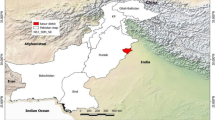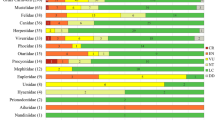Abstract
The bank voleMyodes glareolus Schreber, 1780 is a widely distributed rodent in Europe, being numerically dominant in small mammal communities living in temperate woodlands. However, it becomes scarce in southern Europe (Mediterranean area) where it reaches the southernmost limit of its distribution range. We studied the habitat preferences of bank voles in 9 plots in a transitional area between Mediterranean and Eurosiberian regions within a Mediterranean mountain. During the study period we captured 1919 small mammals of 9 species, including 287 bank voles (14.95%). Mean density ranged from zero individuals per plot (1.1 ha) at the boreo-subalpine scrubland to 10.27 ± 2.84 (SE) at a Mediterranean river woodland. Statistical path analysis was used to investigate relationships between mean bank vole density and climate and vegetation structure measured within plots. The variables selected by the structural equation model were those related to forest structure, like tree cover and height, dead vegetation, moss, and rock cover. Habitat moisture was also important (microclimatic conditions). Mean climate conditions (and elevation) did not have any significant effect on mean bank vole density, and no significant association with understorey vegetation (eg shrub and herbaceous cover) was observed. Our results pointed out that bank voles were habitat specialists in our study area, being more abundant and frequent in moist woodlands, and rare or absent in shrublands and grasslands.
Similar content being viewed by others
References
Adler G. H., Mangan S. A. and Suntsov V. 1999. Richness, abundance, and habitat relations of rodents in the Lang Bian mountains of southern Viet Nam. Journal of Mammalogy 80: 891–898.
Anderson C. S. and Meikle D. B. 2006. Annual changes in structural complexity of understory vegetation and relative abundance ofPeromyscus leucopus in fragmented habitats. Acta Theriologica 51: 43–51.
Arbuckle J. L. 1983–2003. AMOS 5.0, Student Edition. Small Waters Corporation, Chicago, USA.
Bolós O. de 1983. La vegetació del Montseny. Diputació de Barcelona, Barcelona: 1–170.
Canova L. 1993. Resource partitioning between the bank voleClethrionomys glareolus and the wood mouseApodemus sylvaticus in woodland habitats. Bollettino di Zoologia 60: 193–198.
Canova L. and Fasola M. 1991. Communities of small mammals in 6 biotopes of northern Italy. Acta Theriologica 36: 73–86.
Castién E. and Mendiola I. 1985. Atlas de los Mamíferos Continentales de Álava, Vizcaya y Guipúzcoa. [In: Atlas de los Vertebrados Continentales de Álava, Vizcaya y Guipúzcoa. J. Alvarez, A. Bea, J. M. Faus, E. Castién and I. Mendiola, eds]. Estudios Gráficos Zure, S.A., Bilbao: 271–325.
Delibes de Castro J. 1985. Distribution and abundance of small mammals in a gradient of altitude. Acta Zoologica Fennica 173: 53–56.
Everitt B. S. and Dunn G. 1991. Applied multivariate data analysis. Edward Arnold, London: 1–316.
Fasola M. and Canova L. 2000. Asymmetrical competition between the bank vole and the wood mouse, a removal experiment. Acta Theriologica 45: 353–365.
Fernandez F. A. S., Evans P. R. and Dunstone N. 1994. Local variation in rodent communities of Sitka spruce plantations — the interplay of successional stage and site-specific habitat parameters. Ecography 17: 305–313.
Fitzgibbon C. D. 1997. Small mammals in farm woodlands: The effects of habitat, isolation and surrounding landuse patterns. Journal of Applied Ecology 34: 530–539.
González J. and Román J. 1988. Atlas de los micromamíferos de Burgos. Talleres GrÁficos Diario de Burgos, Burgos: 1–153.
Gosàlbez J. 1987. Insectívors i Rosegadors de Catalunya. Ketres Editora S.A., Barcelona: 1–241.
Gosàlbez J. and López-Fuster M. J. 1985. The natural communities of small mammals (insectivores and rodents) of Catalonia (Spain). Miscelània Zoològica 9: 375–387.
Gurnell J. 1985. Woodland rodent communities. [In: The ecology of woodland rodents, bank voles and wood mice. J. R. Flowerdew, J. Gurnell and J. H. W. Gipps, eds]. Symposia of the Zoological Society of London 55: 377–402.
Gurnell J. and Flowerdew J. R. 1990. Live trapping small mammals. A practical guide. Occassional Publications of the Mammal Society of London 3: 1–39.
Halama K. H. and Dueser R. D. 1994. Of mice and habitats: tests for density-dependent habitat selection. Oikos 69: 107–114.
Hesterberg T., Moore D. S., Monaghan S., Clipson A. and Epstein. R. 2005. Bootstrap Methods and Permutation Tests. 2nd edition. W. H. Freeman, New York: 1–82.
Kotzageorgis G. C. and Mason C. F. 1997. Small mammal populations in relation to hedgerow structure in arable landscape. Journal of Zoology, London 242: 425–434.
Krebs C. J. 1999. Ecological methodology. Addison Wesley, New York: 1–620.
Kryŝtufek B. and Griffiths H. I. 1999. Mediterraneanv. Continental small mammal communities and the environmental degradation of the Dinaric Alps. Journal of Biogeography 26: 167–177.
Mazurkiewicz M. 1994. Factors influencing the distribution of the bank vole in forest habitats. Acta Theriologica 39: 113–126.
Montgomery W. I. 1989. Population regulation in the wood mouse,Apodemus sylvaticus. I. Density dependence in spatial distribution and reproduction. Journal of Animal Ecology 58: 477–494.
Moreno E. and Barbosa A. 1992. Distribution patterns of small mammal fauna along gradients of latitude and altitude in Northern Spain. Zeitschrift für Säugetierkunde 57: 169–175.
Morris D. W. 1989. Habitat-dependent estimates of competitive interaction. Oikos 55: 111–120.
Morris D. W. 1996. Coexistence of specialist and generalist rodents via habitat selection. Ecology 77: 2352–2364.
Ninyerola M., Pons X. and Roure J. M. 2003. Atlas Climàtic Digital de Catalunya. Universitat Autònoma de Barcelona and Generalitat de Catalunya.
Olsson G. E., White N., Hjalten J. and Ahlm C. 2005. Habitat factors associated with bank voles (Clethrionomys glareolus) and concomitant hantavirus in northern Sweden. Vector-borne and zoonotic diseases 5: 315–323.
Saint-Girons M. C. 1973. Les mammifères de France et du Benelux. (Faune marine exceptée). Doin, Paris: 1–484.
Saint-Girons M. C. 1984. Le Campagnol roussâtre Clethrionomys glareolus. [In: Atlas des Mammifères sauvages de France]. Societé Française pour l’étude et la Protection des Mammifères, Paris: 160–161.
Sans-Fuentes M. A. and Ventura J. 2000. Distribution patterns of the small mammals (Insectivora and Rodentia) in a transitional zone between the Eurosiberian and the Mediterranean regions. Journal of Biogeography 27: 755–764.
Seamon J. O. and Adler G. H. 1996. Population performance of generalist and specialist rodents along habitat gradients. Canadian Journal of Zoology 74: 1130–1139.
Slade N. A. and Blair S. M. 2000. An empirical test of using counts of individuals captured as indices of population size. Journal of Mammalogy 81: 1035–1045.
Sptizenberger F. 1999.Clethrionomys glareolus (Schreber, 1780). [In: The atlas of European mammals. A. J. Mitchell--Jones, G. Amori, W. Bogdanowicz, B. Kryŝtufek, P. J. H. Reijnders, F. Spitzenberger, M. Stubbe, J. B. M. Thissen, V. Vohralík and J. Zima, eds]. T & AD Poyser, London: 212–213.
Tattersall F. H., Macdonald D. W., Hart B. J., Johnson P., Manley W. and Feber R. 2002. Is habitat linearity important for small mammal communities on farmland? Journal of Applied Ecology 39: 643–652.
Terradas J. and Miralles J. 1986. El patrimoni biològic del Montseny. Catàlegs de flora i fauna 1. Diputació de Barcelona, Barcelona: 1–155.
Torre I. 2004. Distribution, population dynamics and habitat selection of small mammals in Mediterranean environments: the role of climate, vegetation structure, and predation risk. PhD thesis, University of Barcelona, Barcelona: 1–177.
Torre I. and Bosch M. 1999. Effects of sex and breeding status on habitat selection by feral House mice (Mus musculus) in a small Mediterranean island. Zeitschrift für Säugetierkunde 64: 176–186.
Torre I., Tella J. L and Arrizabalaga A. 1996. Environmental and geographic factors affecting the distribution of small mammals in an isolated Mediterranean mountain. Zeitschrieft für Säugetierkunde 61: 365–375.
Van Apeldoorn R. C., Oostenbrink W. T., Vanwinden A. and Vanderzee F. F. 1992. Effects of habitat fragmentation on the bank vole,Clethrionomys glareolus, in an agricultural landscape. Oikos 65: 265–274.
Van Horne B. 1983. Density as a misleading indicator of habitat quality. The Journal of Wildlife Management 47: 893–901.
Wheatley M., Larsen K. W. and Boutin S. 2002. Does density reflect habitat quality for North American Red squirrels during a spruce-cone failure? Journal of Mammalogy 83: 716–727.
Wijnhoven S., Van Der Velde G., Leuven R. S. E. W. and Smits A. J. M. 2005. Flooding Ecology of voles, mice and shrews: the importance of geomorphological and vegetational heterogeneity in river floodplains. Acta Theriologica 50: 453–472.
Wolff J. O. 1999. Behavioral Model Systems. [In: Landscape ecology of small mammals, G. W. Barrett and J. D. Peles, eds]. Springer, New York: 11–40.
Zar J. H. 1996. Biostatistical analysis. Prentice Hall, Englewood Cliffs, New Jersey: 1–662.
Author information
Authors and Affiliations
Corresponding author
Additional information
Associate editor was Magdalena Niedziałkowska.
Rights and permissions
About this article
Cite this article
Torre, I., Arrizabalaga, A. Habitat preferences of the bank voleMyodes glareolus in a Mediterranean mountain range. Acta Theriol 53, 241–250 (2008). https://doi.org/10.1007/BF03193120
Received:
Accepted:
Issue Date:
DOI: https://doi.org/10.1007/BF03193120




